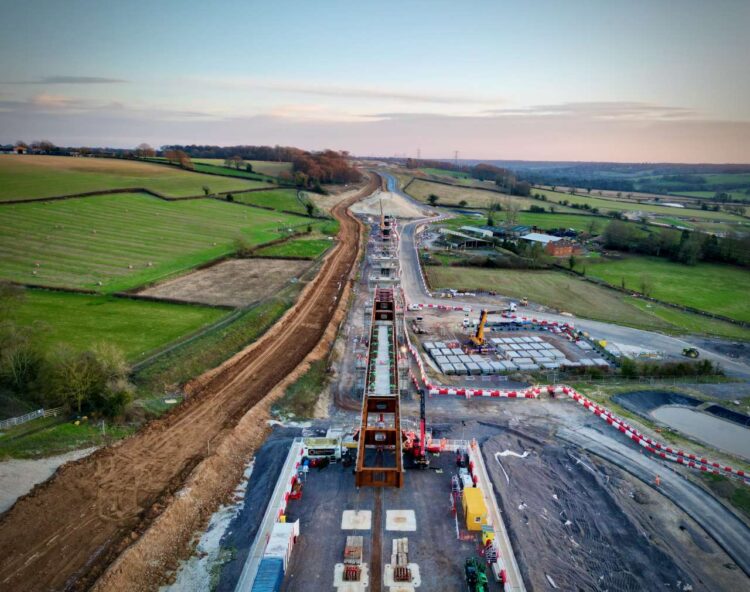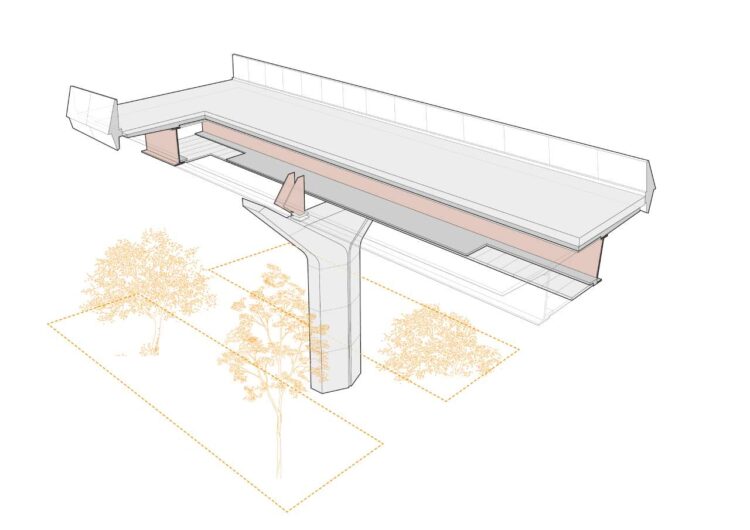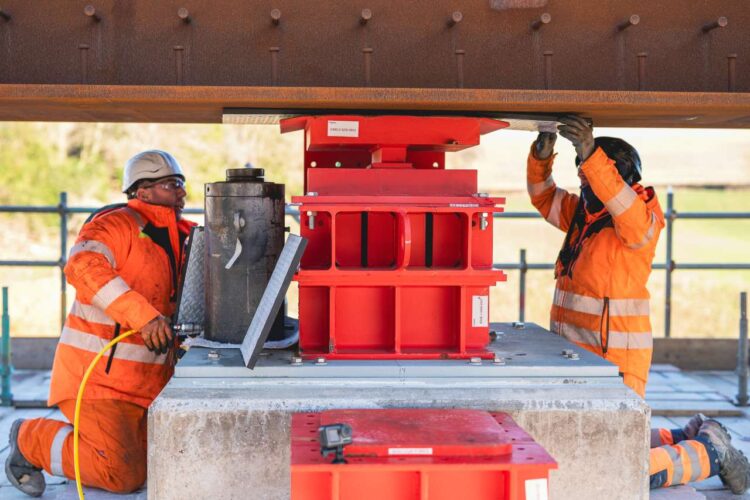HS2 begins viaduct deck slide at Wendover Dean, Buckinghamshire
This week, engineers have begun the next stage of constructing HS2[1]'s Wendover[2] Dean Viaduct, above the Misbourne Valley in Buckinghamshire[3].
The work involves sliding almost half a kilometre of bridge deck into position, and will take around a year.
The viaduct will rest on nine evenly spaced piers, each up to fourteen metres high. The piers consist of hollow pre-cast concrete shells, manufactured in Northern Ireland, which are stacked on top of each other and filled with concrete and steel reinforcing.
HS2 says that it chose this approach to enable a crisp, clean external finish to the concrete, and to reduce the amount of work on site and so minimise disruption[4] for local residents.
Construction of the viaduct will use the ‘double composite' approach, and will be the first major railway bridge in the UK to be built in this way. This construction method uses significantly less carbon-intensive concrete and steel than a more traditional method, allowing HS2 to halve the amount of embedded carbon in the structure.
HS2 predicts that ‘double composite' will cut the carbon footprint of the structure by 56%, saving almost 13,000 tonnes of embodied carbon, and will help it meet its target of halving the amount of embedded carbon in construction.
 Wendover Viaduct deck from above during the first deck slide looking south // Credit: HS2
Wendover Viaduct deck from above during the first deck slide looking south // Credit: HS2
The ‘double composite' method uses two steel beams sandwiched between layers of reinforced concrete to create a lightweight, strong, hollow span between the viaduct piers, whereas previous methods used solid pre-stressed concrete beams to form the spans.
Because the viaduct is 450 metres long, engineers will assemble its deck will in three stages of between 90- and 180-metre sections, pushing out each section from the north abutment before attaching the next section behind it. This weight of the deck will increase with each push, from 590 tonnes this week to 3700 tonnes – the same as 264 double-decker buses – by the end of the year.
HS2 Ltd's main works contractor, EKFB, is building the viaduct. EKFB is made up of Eiffage, Kier, Ferrovial Construction and BAM Nuttall[5]. Specialists at Eiffage Metal are leading the manufacture and installation of the beams being.
 Credit: HS2
Credit: HS2
Engineers will use a winch to push the deck forward at a speed of around nine metres per hour. The deck will slide along pads made of Teflon, a material that is well-known as a non-stick surface for frying pan.
This part of the railway route is in the Chilterns and will be on a slight gradient, so to help maintain control, engineers will push the deck uphill, with the finish point around 1.8m higher than the start point.
The HS2 project involves fifty new viaducts, and this one involves the longest deck slide so far.
The ‘double composite' approach takes its inspiration from structures on the high-speed TGV network in France, and EKFB worked with designer ASC (a joint venture between Arcadis, Setec and COWI) and architects Moxon on developing it.
The viaduct's beams are made from ‘weathering steel' which fades to a dark brown colour over time, as a surface layer of corrosion protects the steel and removes the need for regular painting. HS2 believes that this will help match the natural tone of the surrounding countryside. It is also using the combination of weathering steel and double composite structure at the nearby Small Dean Viaduct, which is at a much earlier stage of construction.
HS2 reports that it has also made significant progress on its other major viaducts over recent months. The first concrete has been poured for the approach viaducts for Birmingham Curzon Street[6] station, and the first beams have been installed at Thame Valley[7] near Aylesbury[8] and the Delta Junction[9] in North Warwickshire[10].
In total, HS2 is building more than five hundred bridging structures, ranging from small road bridges to huge viaducts.
 Specialist engineers from Eiffage Metal carefully slide the Wendover Dean Viaduct deck into position // Credit: HS2
Specialist engineers from Eiffage Metal carefully slide the Wendover Dean Viaduct deck into position // Credit: HS2
Tomas Garcia, HS2 Ltd's Head of Civil Structures said, “Double composite structures maximise the combined strength of steel in tension and concrete in compression. This approach has been tried and tested around the world and it's great to see it applied on this scale for the first time in the UK at Wendover Dean.
“Once complete, HS2 will help enhance the existing rail network by freeing up capacity on the busy West Coast Main Line[11] and almost halving journey times between London[12] and Birmingham[13]. This viaduct will play a crucial role enabling those faster and more reliable services – and I hope it will also inspire other projects around the UK to consider this innovative approach to construction.”
James Collings, EKFB's senior engineer, said, “The project team has reached a fundamental milestone in the build of this industry-leading viaduct. We're progressing well with the first-of-three steel launches being conducted this year and already looking forward to seeing this viaduct come to life. Along with our supply chain partners, Eiffage Metal, we're proud to be delivering this viaduct safely and to programme.”
References
- ^ Posts tagged with HS2 (www.railadvent.co.uk)
- ^ Posts tagged with Wendover (www.railadvent.co.uk)
- ^ Posts tagged with Buckinghamshire (www.railadvent.co.uk)
- ^ Posts tagged with Disruption (www.railadvent.co.uk)
- ^ Posts tagged with BAM Nuttall (www.railadvent.co.uk)
- ^ approach viaducts for Birmingham Curzon Street (www.railadvent.co.uk)
- ^ Thame Valley (www.railadvent.co.uk)
- ^ Posts tagged with Aylesbury (www.railadvent.co.uk)
- ^ the Delta Junction (www.railadvent.co.uk)
- ^ Posts tagged with Warwickshire (www.railadvent.co.uk)
- ^ Posts tagged with West Coast Main Line (www.railadvent.co.uk)
- ^ Posts tagged with London (www.railadvent.co.uk)
- ^ Posts tagged with Birmingham (www.railadvent.co.uk)